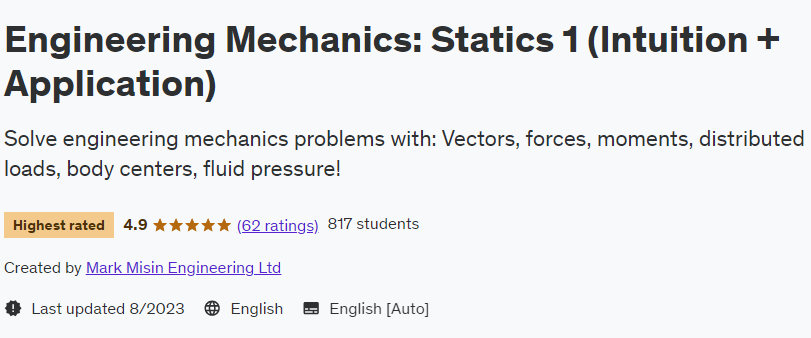Description
Engineering Mechanics Course: Statics 1 (Intuition + Application). Do you want to discover the secrets of structural strength? Use steel cables to stabilize towers? Or balance the giant crane? This course is a gateway to this wonderful world. I, Mark, an aerospace and robotics engineer, am passionate about teaching you the fundamentals of statics. What will you learn in this course?
- Vectors: Learn the language of engineering and master solving complex problems.
- Forces: Discover the secret of balance and stability of structures.
- Torques: Understand torques and use them to analyze the motion of objects.
- Distributed Loads: Simplify complex loads and master structural analysis.
- Center of Gravity: Find the center of balance of objects and use it to analyze motion and stability.
- Fluid Pressure: Overcome the mysterious forces of fluids in underwater structures.
- Center of Area: Discover the Secret of Load Distribution in Complex Sections.
Why choose this course?
- Deep Learning: Gain deep intuition and understanding of static concepts.
- Problem Solving: Improve your ability to solve complex engineering problems in 2D and 3D.
- Proactive and dynamic: Become a true problem solver by solving challenging problems.
- Engaging Animations: Understand concepts with visual and interactive Python animations.
- Strong foundation: prepare to enter more advanced topics such as dynamics and structural analysis.
What you will learn in Engineering Mechanics: Statics 1 (Intuition + Application) course
- The use of force vectors in the analysis and design of structures:
- Stabilization of cable structures (balance of particles): Checking the balance of forces on cable structures and how to distribute stress in them using force vectors.
- Calculation and application of torques: analysis of torques on structures and their impact on their stability and seismic behavior.
- Analysis of distributed loads on structures:
- Description and analysis of distributed loads: investigation of types of distributed loads (such as snow load, wind load) and how to model them as vectors and load distributions.
- Simplifying distributed loads: Introducing different methods for simplifying distributed loads to facilitate the analysis of structures.
- Center, center of mass and center of gravity:
- Calculation of the center, center of mass and center of gravity of the object: determining the coordinates of these points for different geometric shapes and complex objects.
- Application of the center, center of mass and center of gravity: examining the importance of these points in the stability, dynamic and geometric analysis of structures.
- Analysis of underwater structures:
- Hydrostatic fluid pressure: investigating the concept of fluid pressure in deep water and its effect on submerged structures.
- Analysis of underwater structures: analysis of stress, deformation and stability of underwater structures considering fluid pressure and other loads.
- Area center:
- Calculating the center of the area: determining the coordinates of the center of the area for different geometric sections and complex sections.
- Application of center of area: Investigating the importance of center of area in the analysis and design of beams, columns and other structural members.
This course is suitable for people who
- Students: mechanical, civil, aerospace and marine engineering
- Engineers: working in mechanical, civil, aerospace and maritime industries
Specifications of the Engineering Mechanics: Statics 1 (Intuition + Application) course
- Publisher: Udemy
- teacher: Mark Misin Engineering Ltd
- Training level: beginner to advanced
- Training duration: 22 hours and 11 minutes
Course topics on 8/2023
Engineering Mechanics: Statics 1 (Intuition + Application) prerequisites
- Functions, Derivatives and Integrals from Calculus
Course images
Sample video of the course
Installation guide
After Extract, view with your favorite Player.
English subtitle
Quality: 720p
download link
File(s) password: www.downloadly.ir
Size
19.3 GB
